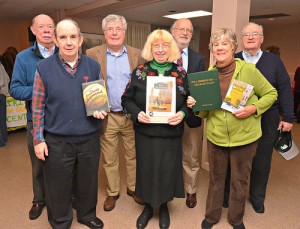Retired research librarian Marita Krivda Poxon had just finished co-writing her 2011 book about the Oak Lane, Olney and Logan neighborhoods of Philadelphia when she started thinking about her next book.
The question: What to write about? Poxon’s editor at Arcadia Publishing, which produced “Oak Lane, Olney and Logan (Images of America),” wasn’t over the moon about any of her ideas for a follow-up, so she found herself casting about, trying to figure out what the editor would be interested in.
Then, Poxon noticed that Arcadia had a pretty successful line of books about ethnic groups: titles like, “African Americans in Amarillo” and “Thais in Los Angeles.”
“I wondered if anyone had done a book on the Irish in Philadelphia, and there was nothing in the Images of America a series,” Poxon recalls. “I couldn’t believe it.”
Poxon called the editor, pitched the idea, and this time found her more receptive.
“She asked what would I call it, and I said ‘Irish Philadelphia.’ And she said, ‘That’s a possibility. We don’t have that, and ethnic books sell.’ They have a book, ‘Italians of Philadelphia,’ that has never been out of print since they first published it 10 years ago. They’ve reprinted it six or seven times.”
Arcadia gave the OK, and now the finished product―crammed with 200 photos and illustrations describing the history of the Irish in Philadelphia since the 17th century―is set to go on sale January 28. (Order it here.) A big book signing party is scheduled for Saturday, February 2, at the Philadelphia Irish Center. (Details here.)
For Poxon, retired after a long and successful career in medical libraries, researching and writing a book was right up her alley in more ways than one. To begin with, her degree in library science from Drexel and years of experience taught her how to sniff out information.
“When I retired, I thought, ‘I can do anything I like.’ That’s how I started writing that regional history book (Oak Lane, Olney and Logan). It was an easy book to write. This kind of book is very defined. It has strict rules: how many pictures, how you format them, how it’s all laid out. It’s rule-bound. As a librarian, I am used to that. Once I got that book under my belt, I thought, ‘Now I can try to do another’.”
But when it came to the Irish Philadelphia book idea, Poxon had another power motivator: her deep familiarity with Irish history and culture. Although Poxon’s father was a Hungarian, born in Budapest, her mother was a Finnegan—Margaret Mary, to be precise—born to a father from County Sligo. Her well-loved uncle Tom Finnegan was very well known around the Philadelphia Irish Center.
Poxon’s Irish roots are deep in yet another way. Back in the late 1960s-early 1970s, she came to love Irish literature while studying English at Temple University. She then moved on to do graduate work at Trinity College in Dublin. She never quite finished her doctorate there. Money was running short, and she had no scholarship funds, so she returned home.
Back in the States, Poxon taught English for a while at the State University of New York. She didn’t like it. So she went through a brief period of self-examination and decided that what she really liked was research and scholarship. That’s what led to the master’s degree from Drexel. Armed with that degree, she began her career at the University of Massachusetts Medical School. Her last job before retirement, after 30 years as a medical librarian, was in the library at Chestnut Hill Hospital. Still, even though she had spent three decades in libraries, she never forgot the early years she devoted to the study of Irish literature and culture.
It was when she started to research her Irish Philadelphia book that Poxon ran into a name that wasn’t familiar to her. It was that of Dennis Clark, author of the seminal book, “The Irish in Philadelphia: Ten Generations of Urban Experience.” It turned out that Clark had been on the faculty at Temple at the same time she was pursuing her studies. “I was in the English department, and he was in city planning or something, so I never ran into him,” Poxon says.
Once introduced to Clark’s incredibly detailed knowledge of the Irish experience in Philadelphia , Poxon was inspired. In fact, Clark’s scholarship served as a useful starting point for much of her work on “Irish Philadelphia,” although Clark’s books and Poxon’s really aren’t at all the same.
“Dennis Clark was an amazing writer, but I bought six of his books, and there wasn’t one picture in any of them,” Poxon says. “He was not a photographic person; he didn’t have a sense of the visual. He saw history happening while it was happening. He was a smart man that way. He was an astute observer of people, but he didn’t like photos.”
The Arcadia series, on the other hand, is a very different kind of book. Poxon followed the trail blazed by Clark, but she did it in a more visual way. She found that approach right up her alley, and she believes it will have a strong appeal for anyone who identifies as Irish in Philadelphia.
“I used a lot of Clark’s ideas, and made them more palatable,” Poxon explains. “These books are like children’s history books, but for adults, and the pictures tell the story.”

